Yaesu Musen 20345X40 AMATEUR RADIO WITH SCANNING RECEIVER User Manual OM
Yaesu Musen Co., Ltd. AMATEUR RADIO WITH SCANNING RECEIVER OM
Contents
- 1. User Manual
- 2. User Manual 1
- 3. User Manual 2
- 4. User Manual 3
- 5. User Manual 4
- 6. User Manual 5
- 7. User Manual 6
- 8. User Manual 7
- 9. User Manual 8
- 10. User Manual 9
- 11. User Manual 10
- 12. User Manual 11
- 13. User Manual 12
- 14. User Manual 13
- 15. User Manual 14
- 16. User Manual 15
- 17. User Manual 16
- 18. User Manual 17
- 19. User Manual 18
- 20. User Manual 19
- 21. User Manual 20
- 22. User Manual 21
User Manual 1
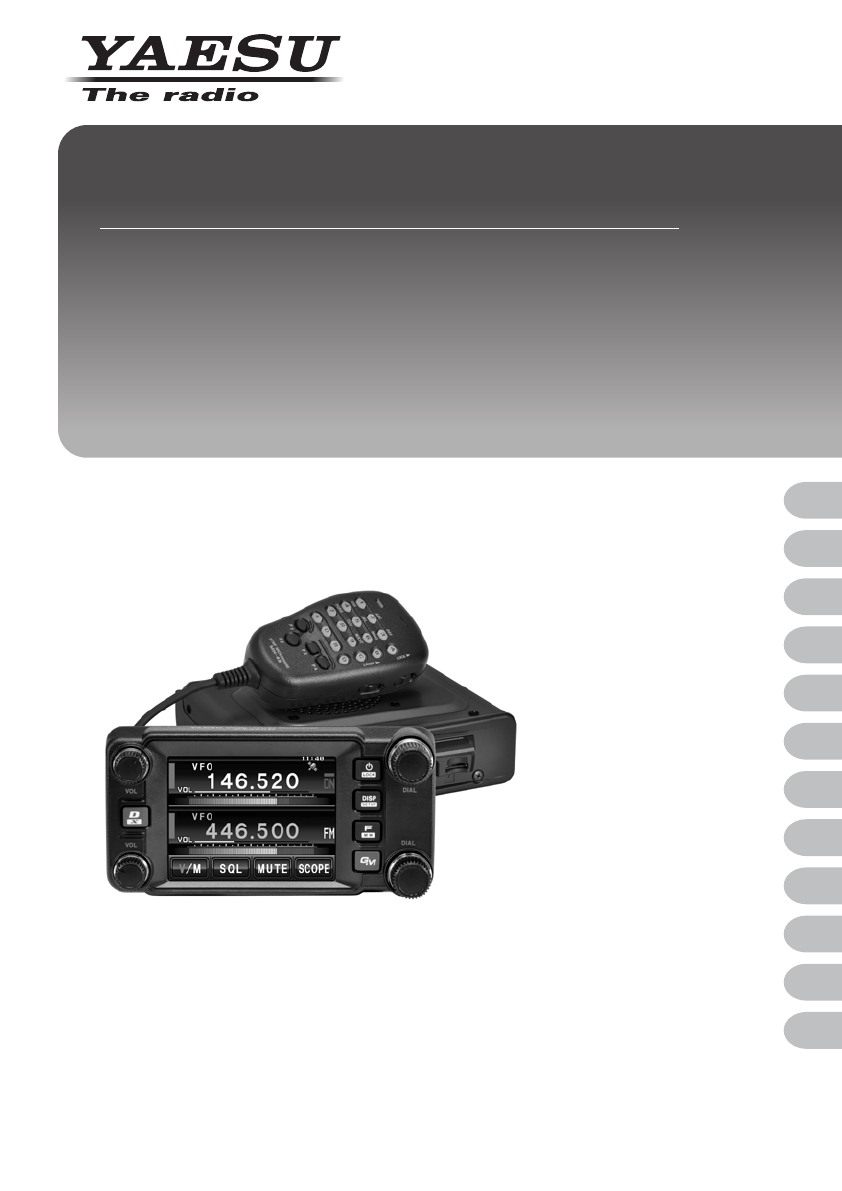
Before Using
Installation and Connection
Basic Operations
Using the Memory
Scanning
Using the GPS Function
Using the APRS Function
Using the GM Function
Convenient Functions
Functions to be used
when Necessary
Customize Menu Settings
and User Preferences
Appendix
144/430MHz 50W
DUAL BAND TRANSCEIVER
C4FM FDMA/FM
Operating Manual
FTM-400XDR/DE
Application for FCC / IC
FCC ID: K6620345X40 / IC: 511B-20345X40

2
Before Using
Introduction
Features of this radio
144/430 MHz dual band mobile radio equipped with standard C4FM digital
communication modem
Clear audio and data communication is achieved using the digital modem functions
Wide band receive in the 108 MHz to 999 MHz range (wireless business, public service
and air band)
Transmit power 50 watts with cooling fan
Full color 3.5-inch LCD, high luminance TFT touch panel controller
Intuitive, user touch panel operation
500 memory channels in the Band A (band at the top of the display) and 500 channels
in the Band B (band at the bottom of the display)
The frequency and settings memories can be saved, using a micro-SD card. The data
in the micro-SD card can easily be copied to other radios
Diverse range of scanning functions (VFO scan, memory scan etc.)
Built-in GPS receiver unit, location and movement information can be displayed and
GPS data can be output to connected devices
Incorporated APRS® functions. Position, movement data and messages can be
communicated to other stations, digipeaters and the Internet.
*Refer to the separate “APRS Operating Manual”
GM (Group Monitor) function where in a group of frequently communicating members
can be registered, and then position information and messages can be exchanged
*Refer to the separate “GM Operating Manual”
Supports Yaesu WIRES-X Internet linking, providing communication with remote
partners using the Internet
*Refer to the separate “WIRES-X Operating Manual”
Bluetooth adaptor unit BU-2 (sold separately) permits hands-free operation
Voice guide unit FVS-2 (sold separately) provides frequency voice announcement, and
recording of received audio
Camera-equipped microphone MH-85A11U (sold separately). Images taken with the
camera can be transmitted to other stations, and also shown on the LCD display.
* The APRS, GM and WIRES-X Operating Manuals are not included with the product.
Please download them from the Yaesu website.
Application for FCC / IC
FCC ID: K6620345X40 / IC: 511B-20345X40

3
Before Using
Introduction
Important precautions for mobile radio operation
The use of protective tape or covering is recommended to protect the wiring and the
power cord inside the vehicle.
When installing the unit inside a vehicle, locate the radio, antenna, co-axial cable, etc.
at least 20 cm away from the following control equipment.
● Engine-related: Fuelinjectionequipmentandenginecontrol
● Transmission-related:Transmissionand4WDelectroniccontrolunit
● Others: ECS/EPS/ABS/ETACS/Fullyautomaticair-conditioner/
Auto-heatercontrolunit/Gsensor
Install the antenna and co-axial cable away from the control unit and wiring harness.
Place all cables so they do not entangle and impede the driver or passengers. Never
place any equipment in a location where it may pose a danger to the passengers,
where it may interfere with driving, or obstruct the driver field of view.
Do not install any apparatus in such a way that it may interfere with the proper operation
of the air bags.
After installing the radio, check that the brake lamp, head lamp, turning indicator lights,
wiper, etc. are working normally with the radio power switched on.
Keep full attention on driving, do not operate the radio controls or look at the radio
display while driving. Stop the vehicle at a safe location, before operating the radio
controls or looking at the display.
Do not drive the car in such a way that external sounds required for safe driving cannot
be heard. Most areas and districts prohibit the use of earphones and headphones
while driving.
When using the radio transmitter, if it appears to have abnormal effects on the control
equipment of the vehicle, stop the engine, turn off the power supply, and disconnect
the power cord. Resolve the problem before continuing to operate the radio equipment.
When using the radio in an electric or hybrid car, the receiver may experience high RF
interference and noise from the inverters that are built into the electric vehicle.
Application for FCC / IC
FCC ID: K6620345X40 / IC: 511B-20345X40

4
Before Using
Introduction
Aboutthetouch panel
●Precautionsinusingthetouchpanel
The touch panel of the controller is designed to work with the slightest touch of a finger.
The touch panel may not work when a protective film or sheet is adhered to the LCD.
Use of a pointed fingernail or pen to operate the touch panel, or pressing too hard may
damage or scratch the screen.
Smart phone operations such as flicking, pinch in and pinch out are not possible.
●Maintainingthetouchpanel
To clean the touch panel, switch off the power supply first before using a dry, soft cloth
to wipe away dust and dirt from the touch panel.
When the touch panel is really dirty, wet a soft cloth and wring it out thoroughly before
using it to wipe the touch panel.
When wiping the touch panel, be careful not to wipe too hard or scratch the surface
with your nails.
When the touch panel is scratched, it may become difficult to see the display.
Aboutregisteredtrademarksandcopyrights
APRS is a registered trademark of Mr. Bob Bruninga of WB4APR.
SmartBeaconing is supplied by HamHUD Nichetronix.
Microsoft, Windows and Windows Vista are registered trademarks of Microsoft
Corporation in the United States and other countries.
Other company and product names listed in this manual are trademarks and registered
trademarks of their respective companies.
Unauthorized reproduction or copying of a part or all of the copyrights owned by Yaesu
Musen Co., Ltd. in any form whatsoever is strictly prohibited.
Application for FCC / IC
FCC ID: K6620345X40 / IC: 511B-20345X40

5
Before Using
Introduction
How to read this manual
In this manual, controller operations are expressed as follows:
Press ............................................Indicates that the key or switch is to be pressed
quickly.
Press for 1 second or longer .........Indicates that the key or switch is to be pressed for
one second or longer.
Touch [SQL] .......................................Indicates that the symbol on the touch panel screen
is to be touched quickly.
Touch [SQL] for 1 second or longer ...Indicates that the symbol on the touch panel screen
is to be touched for one second or longer.
Select [MODE] ...................................Indicates that the items are to be highlighted on the
touch panel screen.
The following symbols are also used in this manual:
Caution
...Explains information to avoid incorrect operation.
Tip
...Explains operating hints and helpful advice.
Also note: the actual product may differ from the drawings shown in this manual.
Application for FCC / IC
FCC ID: K6620345X40 / IC: 511B-20345X40

6
Before Using
Contents
Introduction ................................................................. 2
Features of this radio ............................................. 2
Important precautions for mobile radio operation .. 3
About the touch panel ............................................ 4
About registered trademarks and copyrights ......... 4
How to read this manual ........................................ 5
BeforeUsing ............................................................. 9
Safety Precautions (make sure to read these) ........... 9
Accessories .............................................................. 13
Name and Function of Each Component ................. 14
Controller ............................................................. 14
Front ................................................................ 14
Back ................................................................ 15
Left side ........................................................... 15
Main body ............................................................ 16
Front ................................................................ 16
Back ................................................................ 16
Microphone (MH-48A6JA) ................................... 17
Explanation of the screen .................................... 18
InstallationandConnection .................................. 24
Installing the Radio ................................................... 24
Precautions during installation ............................. 24
Installation location when used in a
mobile unit ......... 24
About the antenna................................................ 25
Install the antenna ........................................... 25
Installing the main body ....................................... 27
Installing the controller ......................................... 28
Connecting the Radio ............................................... 29
Connecting the controller to the main body ......... 29
Connecting the microphone ................................. 29
Connecting the antenna ....................................... 29
Connecting the Power Supply .................................. 30
Connecting the car battery .............................. 30
Connecting the external
power supply equipment ......... 32
Setting Up the micro-SD Card .................................. 33
Micro-SD cards that can be used......................... 33
Things to note when using micro-SD cards ......... 33
Installing the micro-SD card ................................. 34
Removing the micro-SD card .......................... 34
Initializing the micro-SD card ............................... 35
BasicOperations .................................................... 36
Receiving .................................................................. 36
Turning the power on ........................................... 36
Switching the power off ................................... 36
Inputing the call sign ............................................ 37
Switching the operating band............................... 38
Adjusting the volume............................................ 38
Adjusting the squelch level .................................. 39
Tuning the radio ................................................... 40
Changing the frequency steps ........................ 41
Switching the operating mode.............................. 44
Switching the communication mode .................... 45
Switching the modulation mode ........................... 46
Displaying the band scope ................................... 47
Muting the audio .................................................. 48
Communicating......................................................... 49
Transmitting ......................................................... 49
Adjusting the transmit power ........................... 50
Adjusting the sensitivity of the microphone ..... 50
Communicating in the FM mode .......................... 51
Communicating using the repeater ...................... 52
Other Settings........................................................... 54
Changing the beep volume .................................. 54
Locking the knobs and switches .......................... 55
Adjusting the date and time ................................. 56
Adjusting the display brightness .......................... 58
Changing the background color of the
frequency display area ........ 60
Reconfiguring the Settings ....................................... 61
UsingtheMemory .................................................. 62
Writing to the memory .......................................... 62
Recalling the memory .......................................... 63
Recalling the home channel................................. 63
Changing the frequency of the home channel
... 64
Erasing the memory ............................................. 65
Naming the memory............................................. 66
Changing the method of the
memory tag display ....... 67
Split memory ........................................................ 68
Receiving Weather Broadcast Channels
(USA version only) ....... 70
Assigning the “WX” function to a
programmable key on the microphone ....... 71
Recalling the weather channels ...................... 71
Listening the weather alert .............................. 71
Scanning ................................................................. 72
Signal Search ........................................................... 72
VFO scan ............................................................. 72
Setting the receive operation when the
scanning stops .... 73
Memory scan ....................................................... 74
Selecting the scanning method ....................... 75
Setting the specified memories ....................... 75
Scan only the specified memory channels ...... 76
Setting the memories to be skipped ................ 77
Scanning the programmable memories (PMS) .... 79
Writing into the programmable memory .......... 79
Scanning the programmable memory ............. 80
Monitoring the Home Channel .................................. 81
Using the dual receive ..................................... 81
Setting the restart condition of dual receive .... 82
UsingtheGPSFunction ........................................ 83
What is GPS? ........................................................... 83
Positioning Using GPS ............................................. 83
Positioning using an external GPS device ...... 84
Checking the satellite capture status .............. 86
Displaying the position information ...................... 87
Application for FCC / IC
FCC ID: K6620345X40 / IC: 511B-20345X40

Contents
7
Before Using
Displaying the current position
information of your station ........ 87
Displaying the position information
of the partner station in the digital mode ...... 87
Explanation of the position information
screen ...... 88
Recording the position information
(GPS log function)....... 89
Checking the route using a
personal computer ...... 90
Measuring the altitude.......................................... 90
Other settings....................................................... 92
Using the Smart Navigation Function ....................... 93
Displaying the Compass screen ...................... 93
Using the real-time navigation function ................ 94
Using the backtrack function ................................ 95
Saving the destination ..................................... 95
Displaying the position of the
destination in real time ..... 97
UsingtheAPRSFunction ...................................... 98
What is the APRS Function? .................................... 98
UsingtheGMFunction .......................................... 99
What is the GM Function? ........................................ 99
Basic Methods to use the GM function ................... 100
ConvenientFunctions .......................................... 102
Communicating with Specified Partner Stations..... 102
Using the tone squelch ...................................... 102
Setting the tone frequency ............................ 102
Using the tone squelch .................................. 103
Transmitting the tone signal .......................... 103
Using digital code squelch ................................. 104
Setting the DCS code .................................... 104
Using DCS .................................................... 105
Using the pager function .................................... 106
Setting the receive station code .................... 106
Activating the pager function ......................... 108
Recalling a specified station .......................... 108
Notification of an incoming call from a
partner station using the bell ......110
Other squelch functions ......................................110
Using the DTMF Function........................................112
Registering the DTMF code ...........................112
Transmitting the registered DTMF code .........113
Sending out the DTMF code manually ...........114
Using the Timer Function.........................................115
Using the stopwatch function ..............................115
Displaying the timer / clock screen .................115
Using the lap timer .........................................116
Using the countdown timer .............................117
Using the APO function .......................................119
Using the TOT function ...................................... 120
Changing the Touch Key Function .......................... 121
Sending and Receiving Messages and Pictures .... 122
Viewing messages and pictures .................... 122
Sorting the messages and pictures ............... 123
Downloading messages and images ................. 124
Sending messages and pictures ........................ 125
Creating and sending a message ................. 125
Sending saved pictures ................................. 129
Replying to a message or picture .................. 130
Forwarding messages and pictures .............. 132
FunctionstobeUsedwhenNecessary .............. 134
Using the Bluetooth Headset .................................. 134
Mounting the Bluetooth unit “BU-2”.................... 134
Setting the Bluetooth headset operation ............ 136
Identifying the Bluetooth headset ...................... 137
Using the Bluetooth headset .............................. 139
Taking Pictures with the optional Camera
(Snapshot Function) ..... 140
Connecting the speaker microphone
with camera...... 140
Taking pictures ................................................... 141
Viewing a saved picture ..................................... 143
Optional receive Audio Record and Playback ........ 144
Mounting the voice guide unit “FVS-2”............... 144
Using the voice memory .................................... 146
Setting the voice memory operation .............. 146
Recording the receive audio ......................... 147
Replaying the recorded audio ....................... 147
Erasing the recorded audio ........................... 148
Listening to the frequency
voice announcement ........ 149
Setting the announce function operation ....... 149
Listening to the frequency
voice announcement ....... 150
Copying the Radio Data to another Transceiver..... 151
Using the micro-SD card .................................... 151
Copying data to a micro-SD card .................. 151
Copying data from the micro-SD card ........... 152
Using the clone function..................................... 153
Using the Radio with an
External Device Connected .......... 155
Connecting to a personal computer ................... 155
Sending position information
to the computer .......... 156
Updating the firmware of the radio ................ 157
Using the radio as a transceiver
for packet communication ......... 158
Other devices that can be connected ................ 162
CustomizeMenuSettingsand
UserPreferences ......... 163
Set-up Menu Basic Operations............................... 163
Set-up Menu List .................................................... 164
Using the Set-up Menu ........................................... 171
Screen display settings ...................................... 171
Select the screen to be displayed ................. 171
Switching between COMPASS and
POSITION INFORMATION screens .... 172
Setting the display background color ............ 172
Setting the band scope display width ............ 172
Setting the display brightness ....................... 173
Application for FCC / IC
FCC ID: K6620345X40 / IC: 511B-20345X40

8
Before Using
Contents
Setting the display contrast ........................... 173
Switching the time display
and the voltage display ...... 173
Transmit and receive settings ............................ 174
Setting the signal format ............................... 174
Setting the AMS transmission mode ............. 174
Setting the squelch type of the
digital mode ...... 175
Setting the squelch code of the
digital mode ...... 176
Setting the pop-up time for the
partner station information ..... 177
Setting the display method for my position ... 178
Setting the Standby Beep ............................. 178
Displaying the version of the DSP program .. 178
Setting the sub-band mute ............................ 179
Setting the sensitivity of the microphone ....... 179
Memory channel settings ................................... 179
Setting the display method for the
memory tag ...... 179
Setting the memory scan method ................. 179
Tone signal settings ........................................... 180
Setting the squelch tone frequency
(CTCSS) ....... 180
Setting the DCS code .................................... 180
Setting the transmission method
of the DTMF code ...... 180
Registering the DTMF code .......................... 180
Recalling only specified stations ................... 180
Setting the user programmed
reverse CTCSS tone ...... 180
Using the bell Notification of an
incoming call from a partner station
using the bell .... 181
Setting the squelch type separately
for transmit and receive .... 181
Setting the weather alert operation
(USA Version Only) .... 182
Scan settings ..................................................... 182
Setting the signal reception method .............. 182
Setting the scanning direction ....................... 182
Setting the receive operation
when the scanning stops ...... 183
Group monitor function settings ......................... 183
Settings on the functions and configuration ....... 183
Setting the date and time .............................. 183
Setting the display format for the
date and time ...... 184
Setting the time zone .................................... 185
Setting the auto repeater shift ....................... 186
Setting the direction of the repeater shift ...... 186
Setting the shift width of the repeater ............ 187
Setting the frequency step ............................ 188
Setting the volume of the beep ..................... 188
Setting the clock shift of the CPU .................. 188
Setting the program key of the microphone .. 189
Expanding the receive range ........................ 190
Setting the unit display .................................. 191
Switching the power off automatically ........... 191
Limiting the continuous transmission time .... 191
Setting the PIN code of the
optional Bluetooth headset ..... 191
Setting the geodetic reference system
of the GPS function .... 192
Positioning using the external GPS device ... 192
Setting the interval for recording the
GPS position information ... 192
Data communication settings ............................. 193
Setting the COM port .................................... 193
Setting the operating band of the
APRS and data communication .... 196
Setting the baud rate of the APRS and
data communication .... 197
Setting the output condition of the
squelch detection and squelch terminal .... 198
APRS function settings ...................................... 199
Micro-SD card settings....................................... 199
Writing settings to the micro-SD card ............ 199
Writing group IDs to the micro-SD card ......... 200
Initializing the micro-SD card ........................ 200
Optional device settings ..................................... 200
Setting the image of the connected
speaker microphone with camera ..... 200
Setting the operation of the
Bluetooth headset ..... 201
Setting the voice memory operation .............. 201
Initialization and saving settings ........................ 201
Reconfiguring the settings ............................. 201
Registering the preset ................................... 201
Recalling the registered preset ..................... 202
Sorting the registered memory channels ...... 203
Copying saved data ...................................... 203
Call sign settings ................................................ 204
Changing the call sign ................................... 204
Appendix ............................................................... 206
Options List............................................................. 206
Maintenance ........................................................... 207
Care and maintenance....................................... 207
Replacing the fuse ............................................. 207
When you have difficulties ... .................................. 208
There is no power ......................................... 208
There is no sound ......................................... 208
There is no transmission ............................... 208
The keys or knobs will not operate ................ 208
About internal spurious signals .......................... 209
After-market Services ........................................ 209
Specification ........................................................... 210
Index ...................................................................... 212
Application for FCC / IC
FCC ID: K6620345X40 / IC: 511B-20345X40
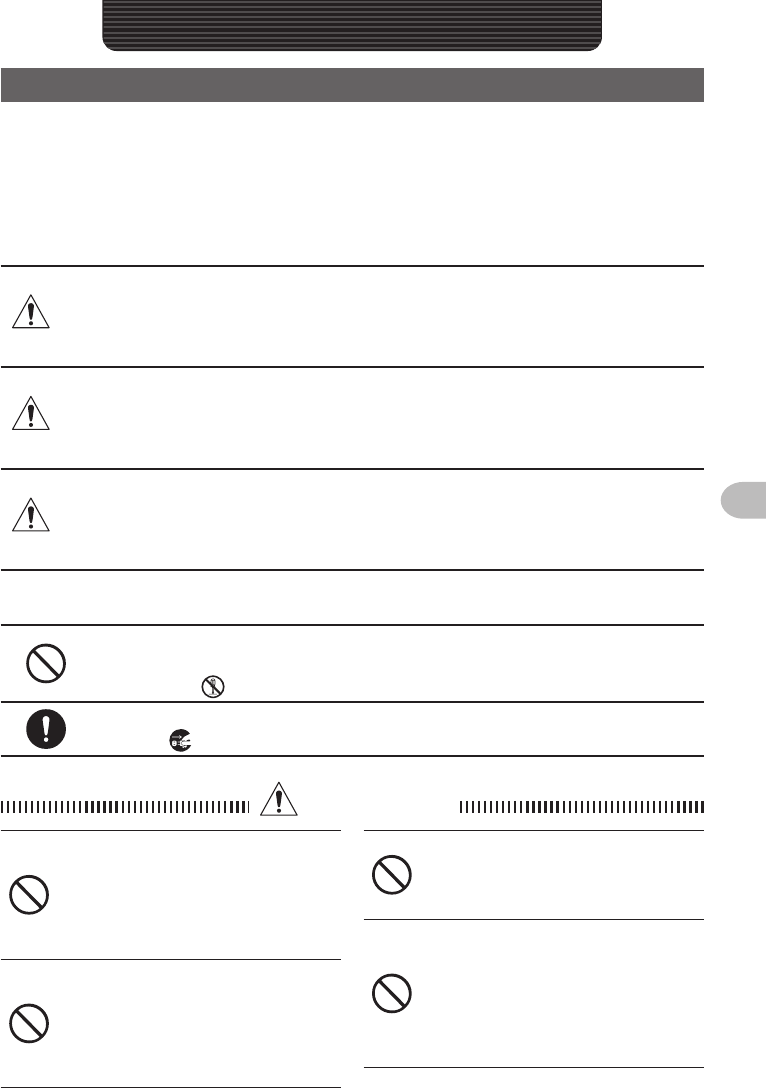
9
Before Using
SafetyPrecautions(makesuretoreadthese)
Makesuretoreadthismanualinordertousethisradiosafelyandcorrectly.
Note beforehand that the company shall not be liable for any damages suffered by the
customer or third parties in using this product, or for any failures and faults that occur
during the use or misuse of this product, unless otherwise provided for under the law.
Typeandmeaningofthemarks
DANGER
This symbol indicates the possibility of death or serious injury
being inflicted on the user and the surrounding people when
these instructions are ignored and the product is handled
wrongly.
WARNING
This symbol indicates the possibility of death or serious injury
being inflicted on the user and the surrounding people when
these instructions are ignored and the product is handled
wrongly.
CAUTION
This symbol indicates the possibility of physical impediments
occurring or impediments being inflicted on the user and the
surrounding people when these instructions are ignored and
the product is handled wrongly.
Typeandmeaningofsymbols
Prohibited actions that must not be carried out in order to use this radio
safely.
For example, signifies that disassembly is prohibited.
Precautions that must be adhered to in order to use this radio safely. For
example, signifies that the power supply is to be disconnected.
DANGER
Donotusethedevicein“regionsor
aircraftsandvehicleswhereitsuse
is prohibited” such as in hospitals
and aeroplanes.
This may exert an impact on electronic
and medical devices.
Donotusethisproductwhiledriving
orridingamotorbike.Thismay
result in accidents.
Make sure to stop the car in a safe
location first before use if the device is
going to be used by the driver.
Nevertouchtheantennaduring
transmission.
This may result in injury, electric shock
and equipment failure.
Whenanalarmgoesoffwiththe
externalantennaconnected,cut
offthepowersupplytothisradio
immediatelyanddisconnectthe
externalantennafromthisradio.
If not, this may result in fire, electric
shock and equipment failure.
BeforeUsing
Application for FCC / IC
FCC ID: K6620345X40 / IC: 511B-20345X40
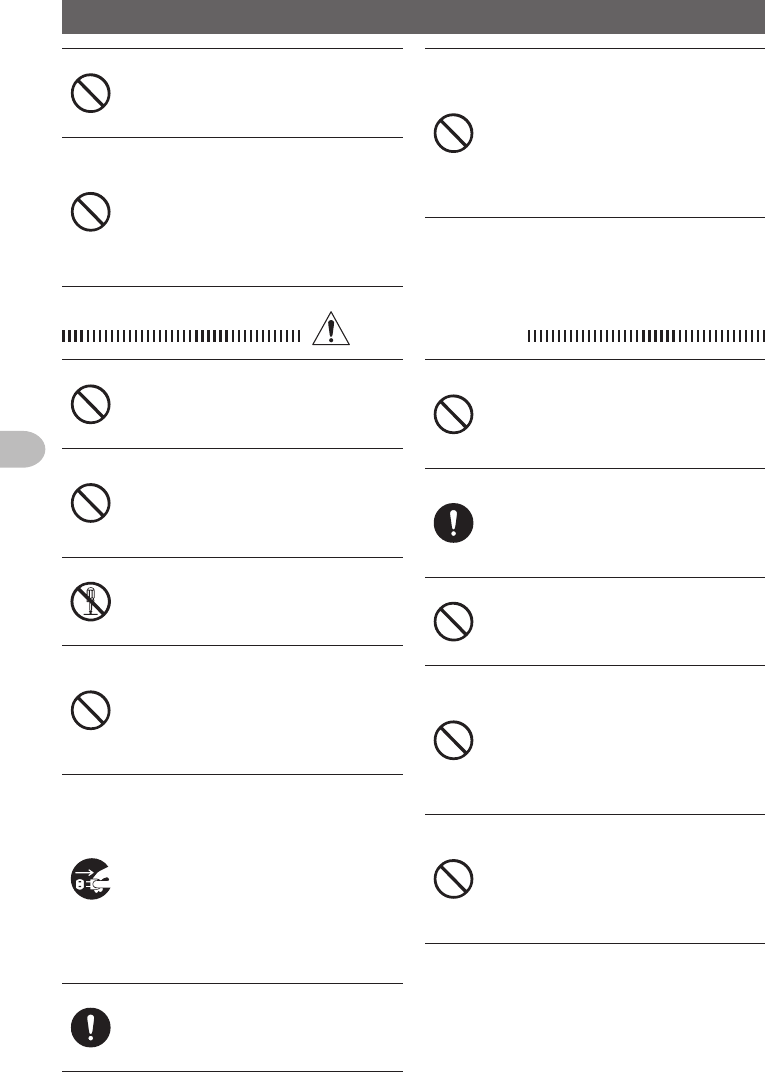
10
Before Using
SafetyPrecautions(makesuretoreadthese)
Donotoperatethedevicewhen
flammablegasisgenerated.
Doing so may result in fire and
explosion.
Donottransmitincrowdedplaces
in consideration of people who are
fittedwithmedicaldevicessuchas
heartpacemakers.
Electromagnetic waves from the device
may affect the medical device, resulting
in accidents caused by malfunctions.
Donottouchanyliquidleakingfrom
theliquiddisplaywithyourbare
hands.
There is a risk of chemical burns
occurring when the liquid comes
into contact with the skin or gets into
the eyes. In this case, seek medical
treatment immediately.
WARNING
Donotusevoltagesotherthanthe
specifiedpowersupplyvoltage.
Doing so may result in fire and electric
shock.
Donottransmitcontinuouslyfor
longperiodsoftime.
This may cause the temperature of the
main body to rise and result in burns
and failures due to overheating.
Donotdismantleormodifythe
device.
This may result in injury, electric shock
and equipment failure.
Donothandlethepowerplugand
connectoretc.withwethands.Also
donotplugandunplugthepower
plugwithwethands.
This may result in injury, liquid leak,
electric shock and equipment failure.
Whensmokeorstrangeodorsare
emittedfromtheradio,turnoffthe
power and disconnect the power
cordfromthesocket.
This may result in fire, liquid leak,
overheating, damage, ignition and
equipment failure. Please contact our
company amateur customer support or
the retail store where you purchased
the device.
Keepthepowerplugpinsandthe
surroundingareascleanatalltimes.
This may result in fire, liquid leak,
overheating, breakage, ignition etc.
Donotplacethedeviceinareas
thatmaygetweteasily(e.g.neara
humidifier).
This may result in fire, electric shock
and equipment failure.
WhenconnectingaDCpowercord,
payduecarenottomixupthe
positiveandnegativepolarities.
This may result in fire, electric shock
and equipment failure.
DonotuseDCpowercordsother
than the one enclosed or specified.
This may result in fire, electric shock
and equipment failure.
Donotbend,twist,pull,heat
andmodifythepowercord
and connection cables in an
unreasonable manner.
This may cut or damage the cables
and result in fire, electric shock and
equipment failure.
Donotpullthecablewhenplugging
andunpluggingthepowercordand
connection cables.
Please hold the plug or connector when
unplugging. If not, this may result in fire,
electric shock and equipment failure.
Application for FCC / IC
FCC ID: K6620345X40 / IC: 511B-20345X40
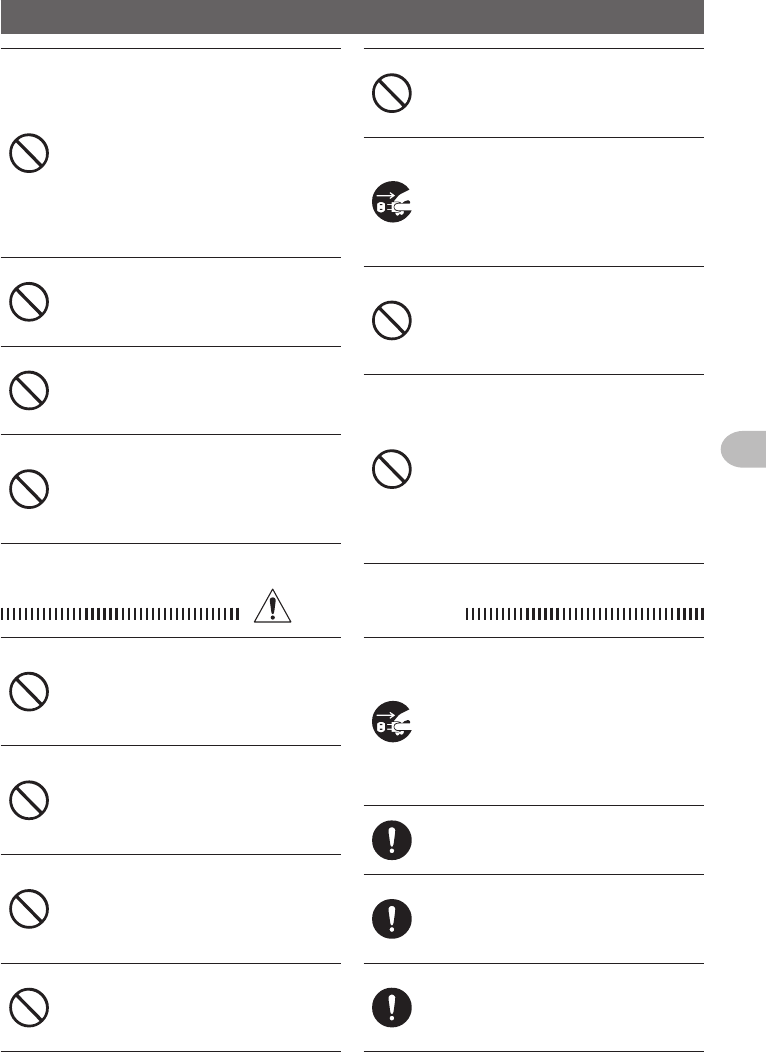
11
Before Using
SafetyPrecautions(makesuretoreadthese)
Donotusethedevicewhenthe
power cord and connection cables
aredamaged,andwhentheDC
powerconnectorcannotbeplugged
intightly.
Please contact our company amateur
customer support or the retail store
where you purchased the device as this
may result in fire, electric shock and
equipment failure.
Nevercutoffthefuseholderofthe
DCpowercord.
This may cause short-circuiting and
result in ignition and fire.
Donotusefusesotherthanthose
specified.
Doing so may result in fire and
equipment failure.
Donotallowmetallicobjectssuch
aswiresandwatertogetinsidethe
product.
This may result in fire, electric shock
and equipment failure.
Refrainfromusingheadphonesand
earphonesataloudvolume.
Continuous exposure to loud volumes
may result in hearing impairment.
Disconnectthepowercord
and connection cables before
incorporatingitemssoldseparately
andreplacingthefuse.
This may result in fire, electric shock
and equipment failure.
Followtheinstructionsgivenwhen
installingitemssoldseparatelyand
replacingthefuse.
This may result in fire, electric shock
and equipment failure.
Donotusethedevicewhenthe
alarmgoesoff.
For safety reasons, please pull the
power plug of the DC power equipment
connected to the product out of the AC
socket.
Never touch the antenna as well. This
may result in fire, electric shock and
equipment failure due to thunder.
CAUTION
Donotplacethisdeviceneara
heatinginstrumentorinalocation
exposedtodirectsunlight.
This may result in deformation and
discoloration.
Donotplacethisdeviceinalocation
where there is a lot of dust and
humidity.
Doing so may result in fire and
equipment failure.
Stayasfarawayfromtheantennaas
possibleduringtransmission.
Long-term exposure to electromagnetic
radiation may have a negative effect on
the human body.
Donotwipethecaseusingthinner
andbenzeneetc.
Please use a soft and dry piece of cloth
to wipe away the stains on the case.
Forsafetyreasons,switchoffthe
powerandpullouttheDCpower
cordconnectedtotheDCpower
connectorwhenthedeviceisnot
goingtobeusedforalongperiod
of time.
If not, this may result in fire and
overheating.
Donotthroworsubjectthedeviceto
strongimpactforces.
This may result in equipment failure.
Donottheputthisdevicenear
magneticcardsandvideotapes.
The data in the cash card and video
tape etc. may be erased.
Donotturnonthevolumetoo
highwhenusingaheadphoneor
earphone.
This may result in hearing impairment.
Application for FCC / IC
FCC ID: K6620345X40 / IC: 511B-20345X40
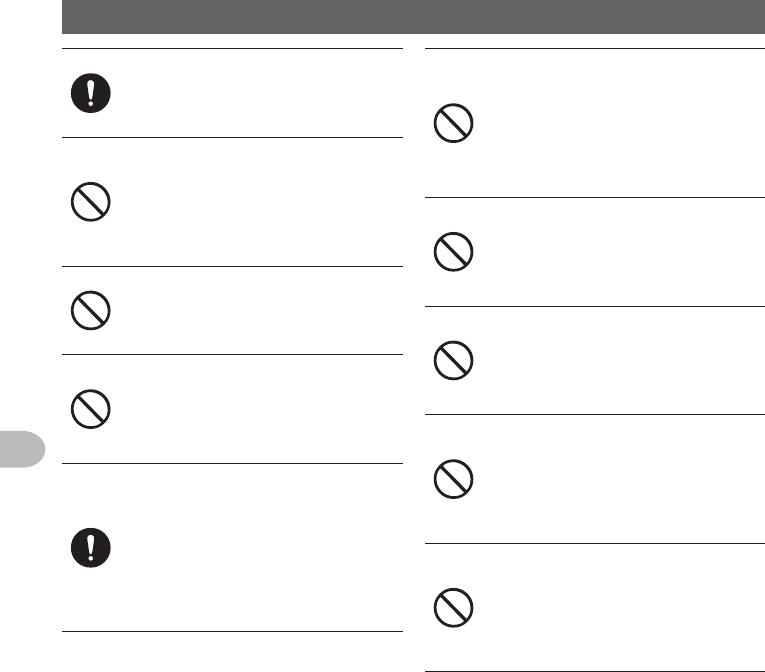
12
Before Using
SafetyPrecautions(makesuretoreadthese)
Keep out of the reach of small
children.
If not, this may result in injuries to
children.
Donotputheavyobjectsontop
of the power cord and connection
cables.
This may damage the power cord and
connection cables, resulting in fire and
electric shock.
Donottransmitnearthetelevision
and radio.
This may result in electromagnetic
interference.
Donotuseoptionalproducts
otherthanthosespecifiedbyour
company.
If not, this may result in equipment
failure.
Whenusingthedeviceinahybrid
carorfuel-savingcar,makesure
tocheckwiththecarmanufacturer
beforeusing.
The device may not be able to receive
transmissions normally due to the
influence of noises from the electrical
devices (inverters etc.) fitted in the car.
Donotplacethedeviceonan
unsteadyorslopingsurface,orin
a location where there is a lot of
vibration.
The device may fall over or drop,
resulting in fire, injury and equipment
failure.
Donotstandontopoftheproduct,
anddonotplaceheavyobjectson
toporinsertobjectsinsideit.
If not, this may result in equipment
failure.
Donotuseamicrophoneotherthan
thosespecifiedwhenconnectinga
microphonetothedevice.
If not, this may result in equipment
failure.
Donottouchtheheatradiating
parts.
When used for a long period of time,
the temperature of the heat radiating
parts will get higher, resulting in burns
when touched.
Donotopenthecaseoftheproduct
exceptwhenreplacingthefuse
andwheninstallingitemssold
separately.
This may result in injury, electric shock
and equipment failure.
Application for FCC / IC
FCC ID: K6620345X40 / IC: 511B-20345X40
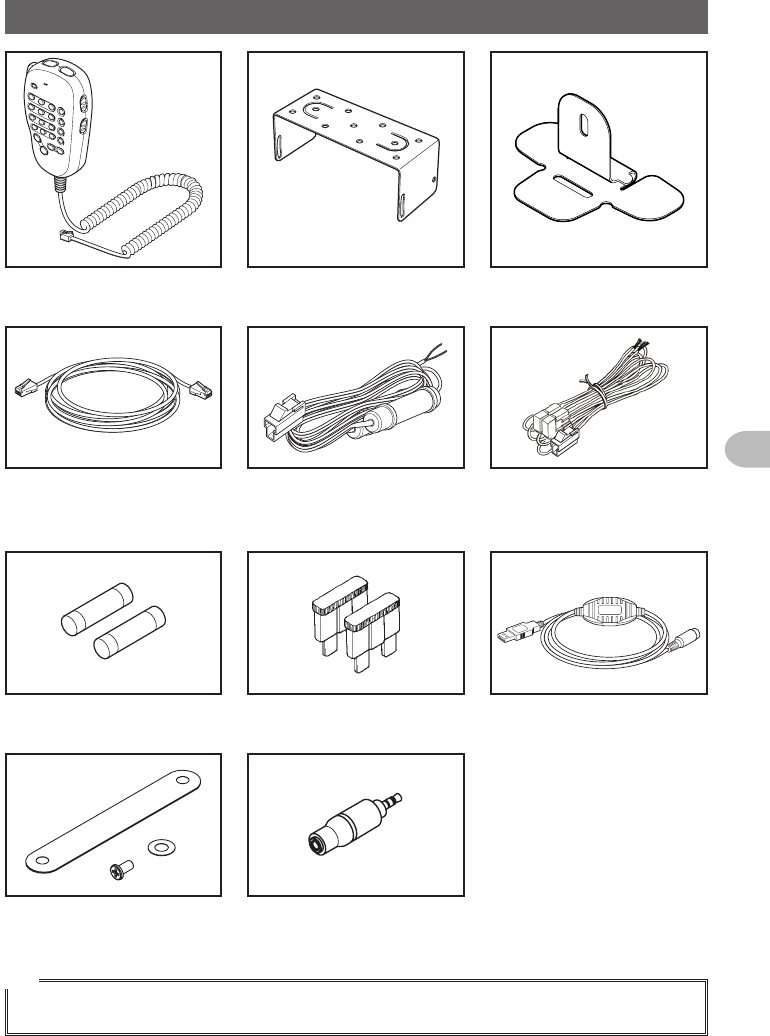
13
Before Using
Accessories
DTMF microphone
MH-48A6JA
Bracket for main body
MMB-36
Bracket for the
controller
Controller cable
(3 m)
DC power cable
(with fuse attached)
(USA, EXP version)
DC power cable
(with fuse attached)
(European version)
Spare fuse (15 A)
(USA, EXP version)
Spare Fuse (15 A)
(European version)
PC connection cable
SCU-20
Operating Manual
Warranty Card
Quick Manual
Microphone cord holder
Stereo to Monaural Plug
Tip
Various optional parts are also available.
Refer to Page 206 for details.
Application for FCC / IC
FCC ID: K6620345X40 / IC: 511B-20345X40
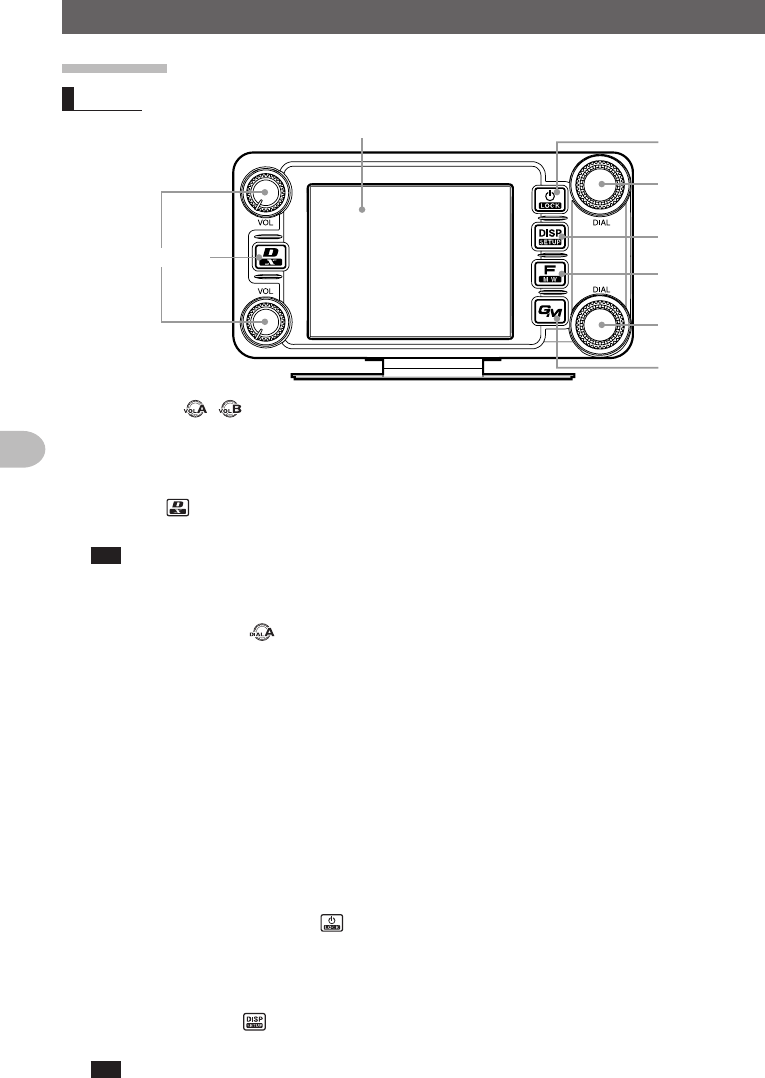
14
Before Using
NameandFunctionofEachComponent
Controller
Front
➀
➃
➄
➅
➆
➇
➈
➁
➂
➀ VOL knob ( )
The volume will increase when the knob is turned in a clockwise direction and
decrease when turned in an counter-clockwise direction.
The upper end is for Band A use while the lower end is for Band B use.
➁ D/X key ( )
The communication mode changes each time this key is pressed for a short time.
Tip Refer to Page 45 for the communication mode.
WIRES-X will start when this key is pressed for one second or longer.
➂ Touch panel display
➃ Band A DIAL knob ( )
• The frequency of the upper band in the dual band display can be adjusted.
The frequency will increase when the knob is turned in a clockwise direction and
decrease when turned in an counter-clockwise direction.
Press the knob to enable setting the operating band frequency in 1 MHz units.
Press the knob for one second or longer to enable setting the frequency in 5 MHz
units.
• In memory mode when the knob is pressed for one second or longer, if a tag
(name) is attached to the memory channel, the tag and frequency displays will be
reversed.
• This knob is also used to select the items during the set up and memory
operations, group monitor operations, etc.
➄ Power supply/LOCK switch ( )
Press this button for 2 seconds or longer to switch the power on and off.
The key lock can be engaged or released by pressing the button quickly while the
radio is turned on.
➅ DISP/SETUP key ( )
The display screen will change each time the button is pressed quickly.
Tip Refer to Page 20 for the display.
Press the button for one second or longer to display the set-up menu.
Application for FCC / IC
FCC ID: K6620345X40 / IC: 511B-20345X40
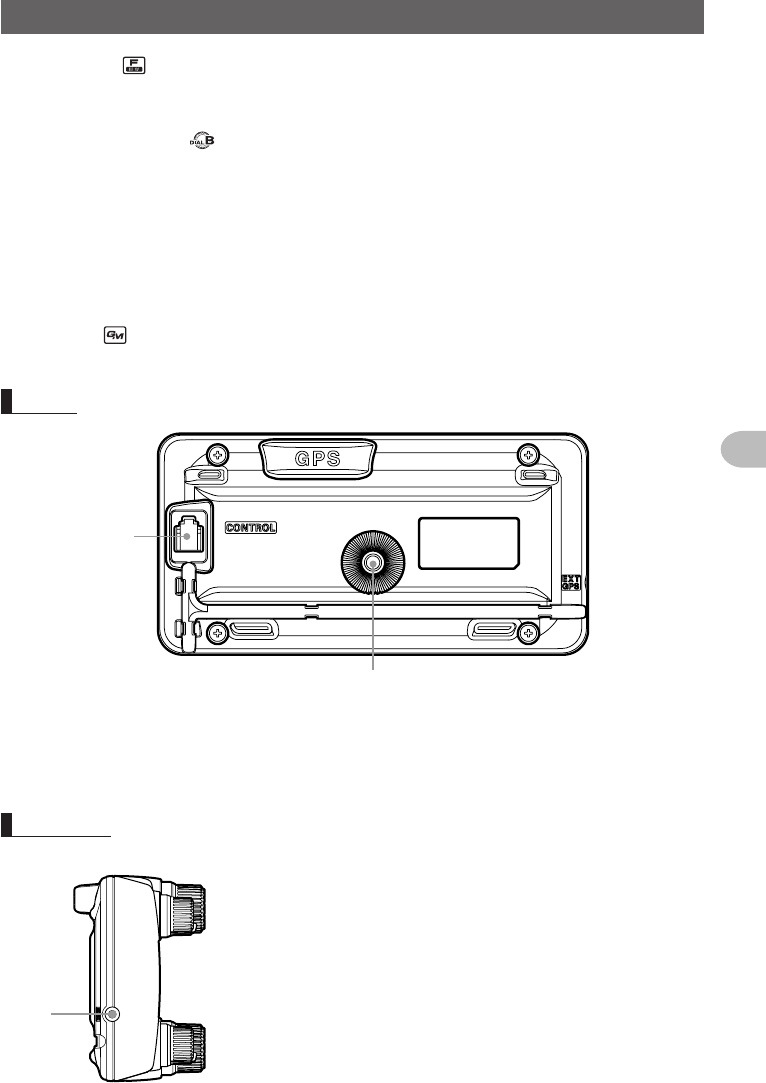
15
Before Using
NameandFunctionofEachComponent
➆ F/MW key ( )
Press the button quickly to display the function menu.
Press the button for 2 seconds or longer to change to the memory writing mode.
➇ Band B DIAL knob ( )
• The frequency of the upper band in the dual band display can be adjusted.
Press the knob to enable setting the operating band frequency in 1 MHz units.
Press the knob for one second or longer to enable setting the frequency in 5 MHz
units.
• In memory mode when the knob is pressed for one second or longer, if a tag
(name) is attached to the memory channel, the tag and frequency displays will be
reversed.
➈ GM key ( )
Press this key to start the group monitor function.
Back
➀
➁
➀ CONTROL jack
Plug in the control cable into this jack to connect with the main body.
➁ Screw hole to attach the mounting bracket
Leftside
➀
➀ EXT GPS jack
Plug in a cable to connect with external GPS devices.
Application for FCC / IC
FCC ID: K6620345X40 / IC: 511B-20345X40
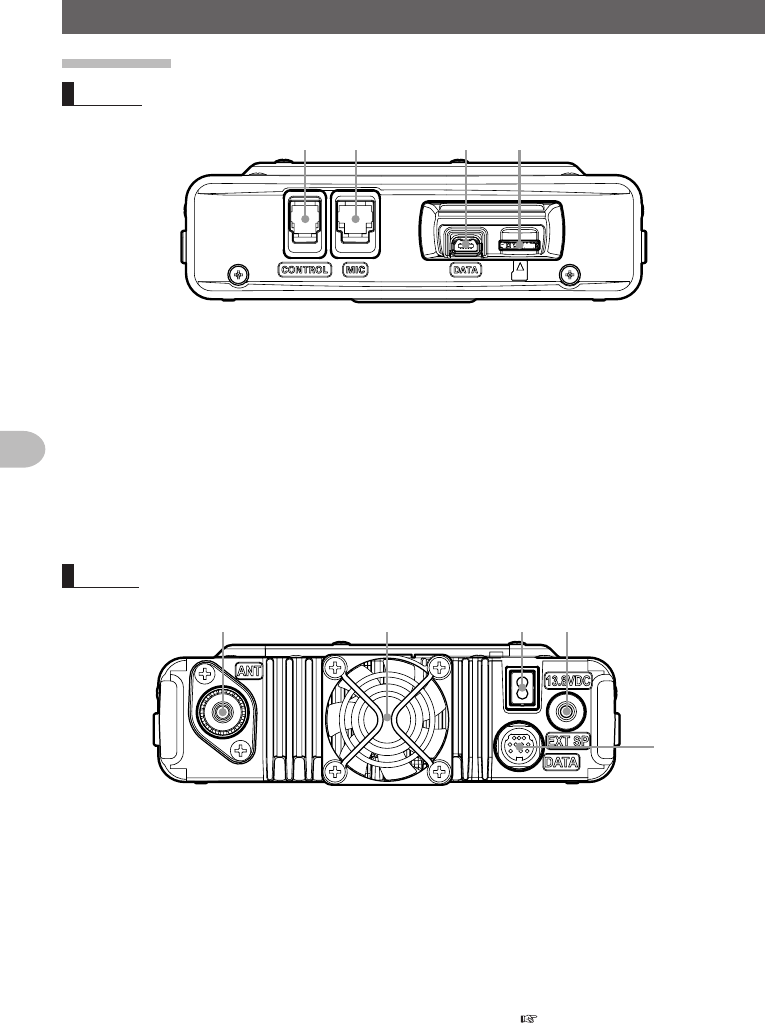
16
Before Using
NameandFunctionofEachComponent
Mainbody
Front
➀➁ ➂➃
➀ CONTROL jack
Plug in the control cable into this jack to connect with the controller.
➁ MIC jack
Plug in the provided microphone cable.
➂ DATA jack
Connect MH-85A11U, the optional speaker microphone with camera.
* There is no audio output available from the FTM-400XDR/DE to the MH-85A11U
speaker.
➃ micro-SD card slot
Back
➀➄➁
➃
➂
➀ ANT terminal
Connect the co-axial cable for the antenna.
➁ 13.8 VDC
Connect the provided DC power supply cable (with fuse attached).
➂ EXT SP jack
Connect the optional external speaker.
➃ DATA jack
Connect a cable for remote operation or the cable for connecting with the personal
computer interface unit and the external terminal unit ( P.155 Page).
➄ Cooling fan
Application for FCC / IC
FCC ID: K6620345X40 / IC: 511B-20345X40
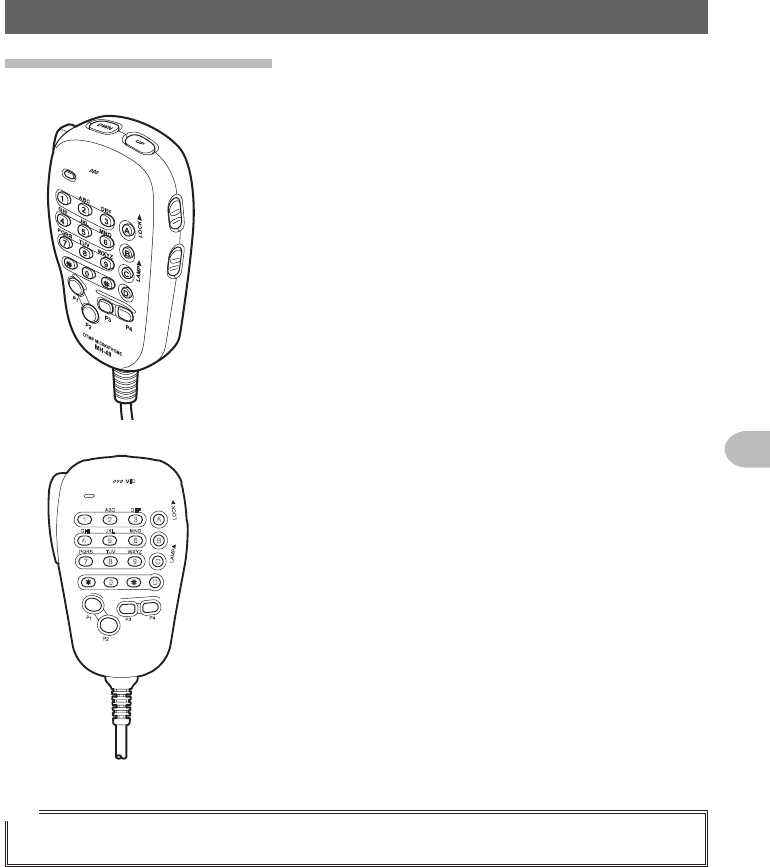
17
Before Using
NameandFunctionofEachComponent
Microphone(MH-48A6JA)
LOCK
P3
P2
P1
7
1
4
8
2
0
5
9
B
A
C
D
3
6
P4
LAMP
DTMF MICROPHONE
MH-48
ABC
JKL
TUV
GHI
PQRS
DEF
MNO
WXYZ
MIC
[UP] Frequency is increased by 1 step.
[DWN] Frequency is decreased by 1 step.
[LOCK] Locks / unlocks the [UP] and [DWN] keys and
[P1] to [P4] keys.
[LAMP] Turns the lamp on the body of the microphone
on/off.
[MIC] Speak into here during transmission.
[1]to[0] Enters the numbers and letters.
[✽] Changes the VFO/Memory operating mode of
the operating band.
[#] Activates the GM (Group Monitor) functions.
[A] Switches the operating band to Band A.
[B] Switches the operating band to Band B.
[C] Adjusts the squelch level.
[D] Switches the display.
[P1] Turns off the squelch
(T.CALL: European version).
[P2] Recalls the receiver home channel.
[P3] Changes the communication mode.
[P4] Changes the transmit power.
[PTT] Press this key to begin the transmit mode.
Tip
Preferred functions can be assigned to buttons [P1] to [P4]. Select using the [CONFIG]→[10MIC
PROGRAMKEY] in the set-up menu.
Application for FCC / IC
FCC ID: K6620345X40 / IC: 511B-20345X40